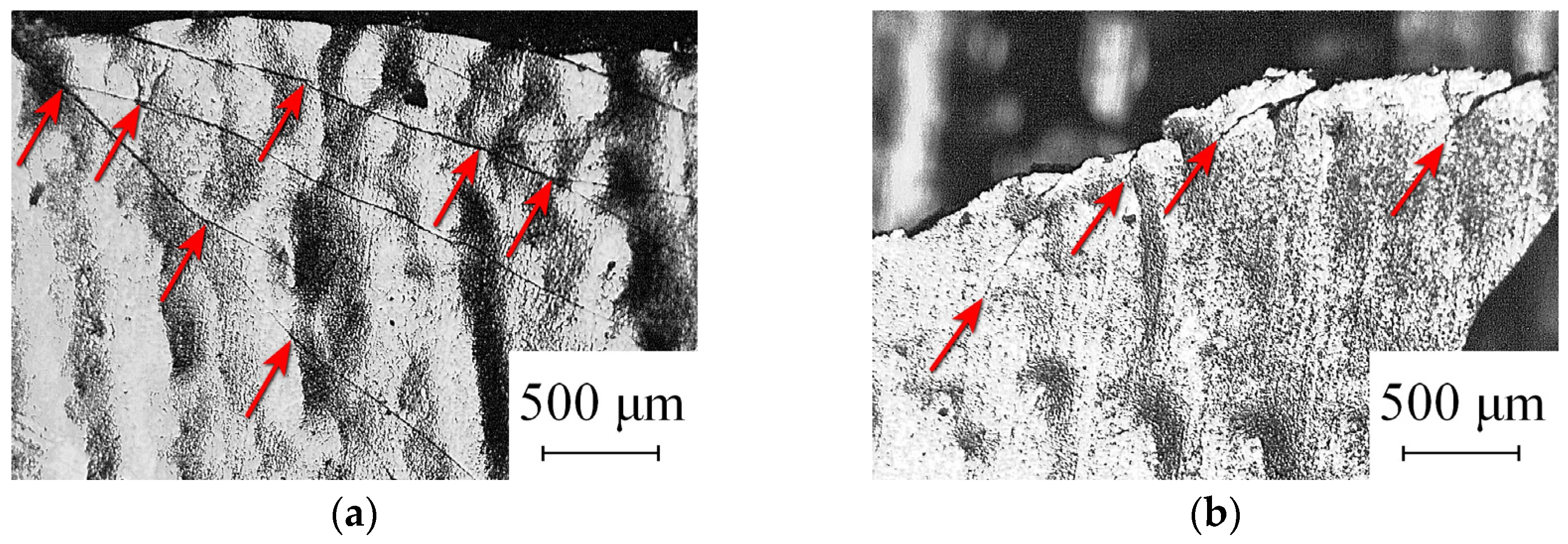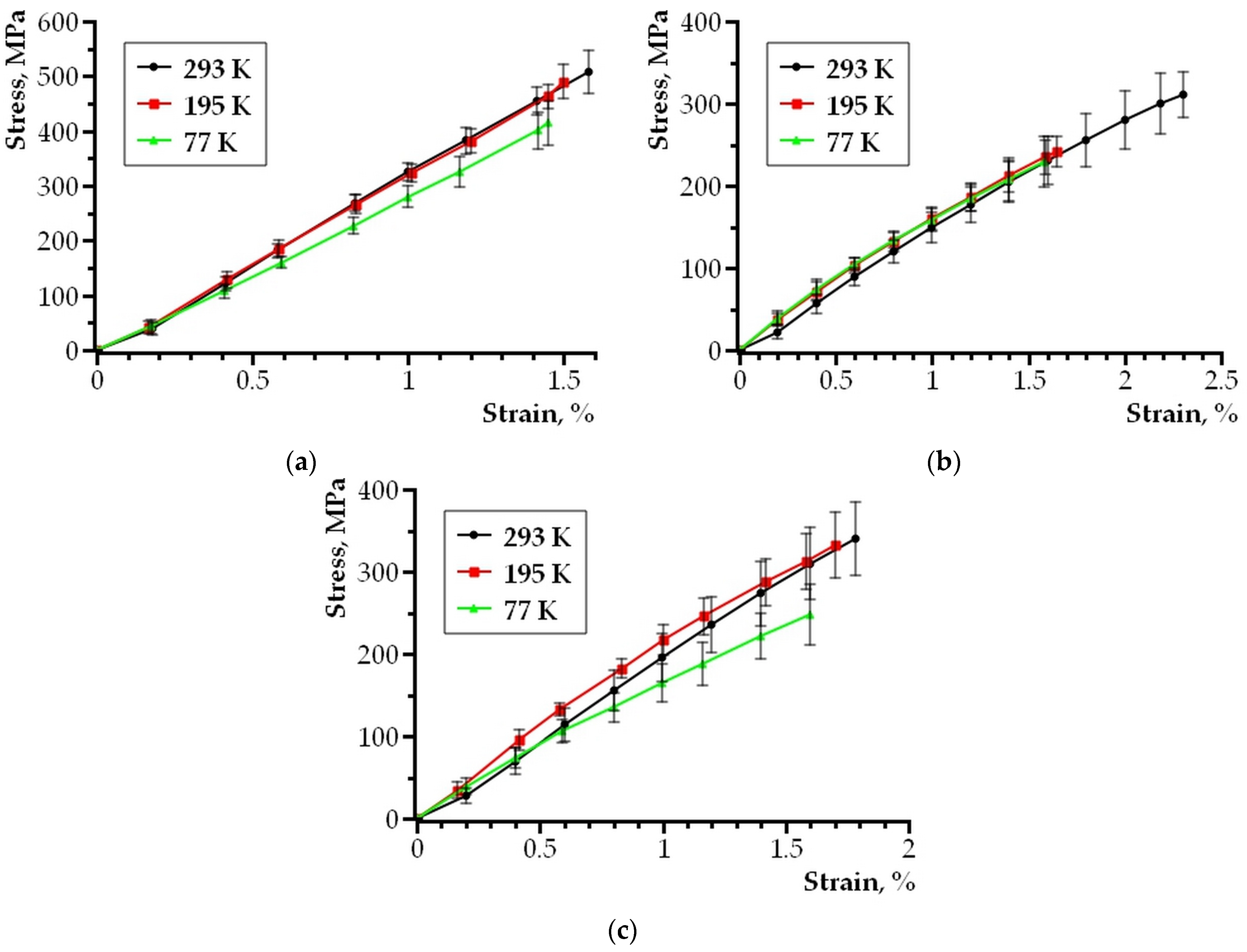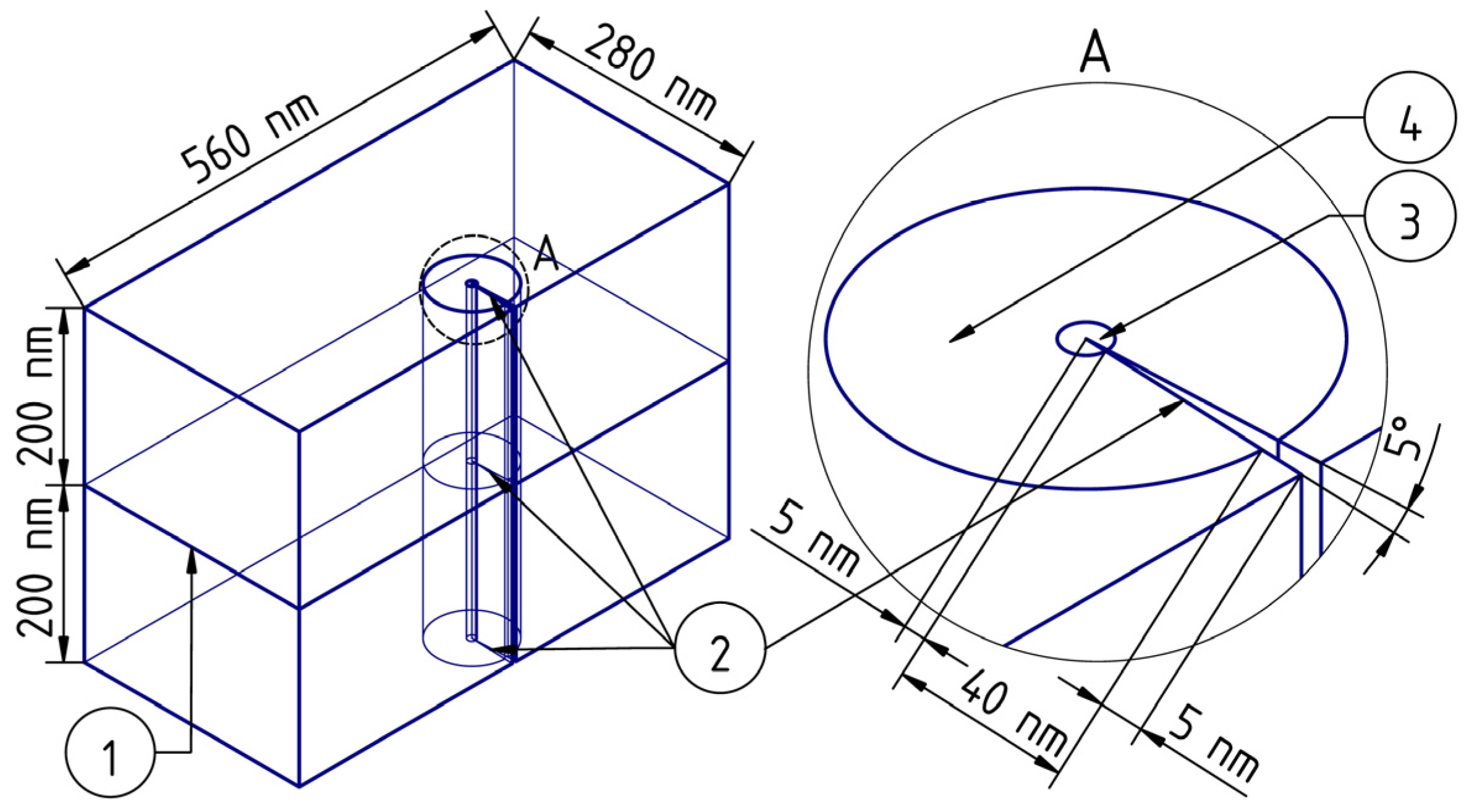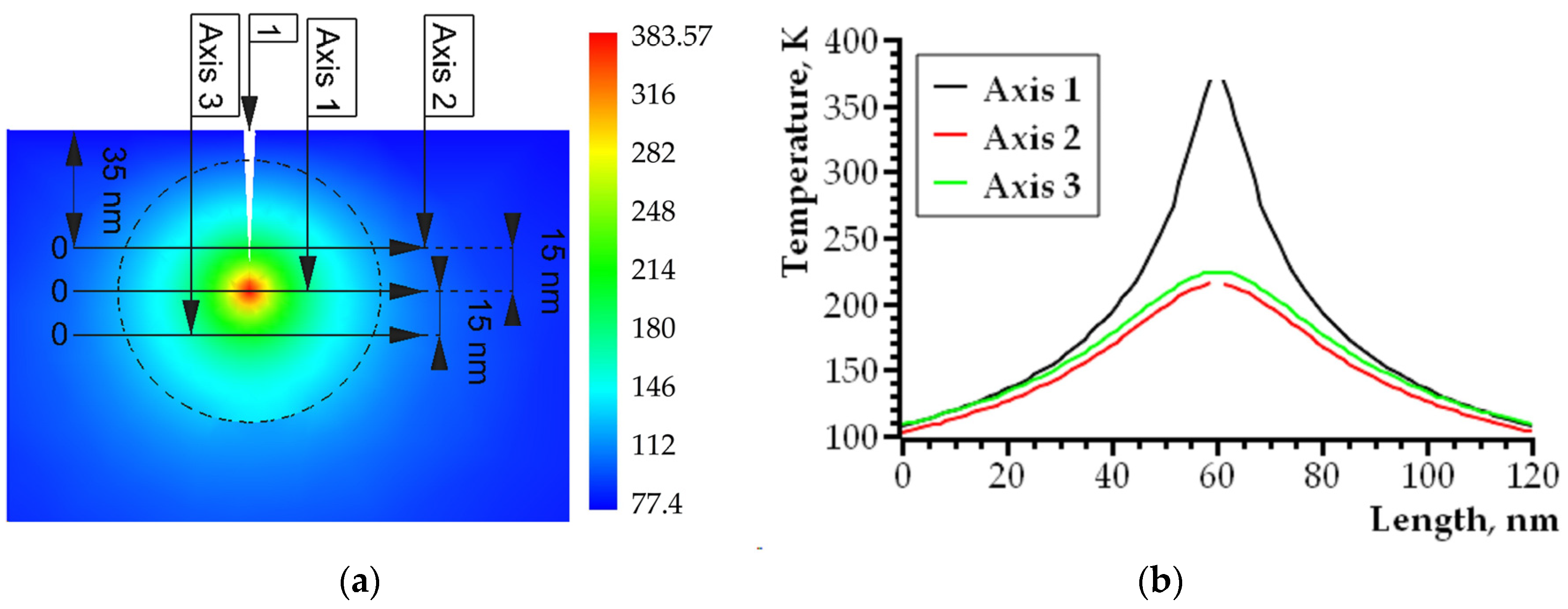Physical Mechanism of Nanocrystalline Composite Deformation Responsible for Fracture Plastic Nature at Cryogenic Temperatures
Abstract
:1. Introduction
2. Materials and Methods
3. Results
3.1. Experimental Results
3.2. Theoretical Analysis
3.3. Simulation Results
4. Conclusions
- The effect of self-heating at the growing crack tip is realized at the nanoscale boundary layer between nanocrystalline/amorphous metal alloys and crystalline fusible alloys. This effect was detected in a temperature range of 77–293 K. The local heating zone at the crack tip ensures the viscous nature of the composite fracture by the main crack and the inhibition of fracture for branched cracks. Self-heating of the material at the moment of crack growth initiation is localized at the boundary layer (between the nanocrystalline/amorphous and crystalline phases), and then spreads to the entire area at the top of the growing crack. The effect of self-heating at the crack tip can change the nature of fracture from brittle to viscous even at cryogenic temperatures.
- A physical model of deformation and fracture at the boundary of nanocrystalline/amorphous and crystalline phases in thin-layer composite compounds is proposed. The simulation results confirm the exothermic crack growth in the entire temperature range of 77 K, 195 K and 293 K under uniaxial stretching of the sample. The model suggests the origin of a crack at the interface between two components of a nanocrystalline/amorphous film and a low-melting metal alloy with further propagation deep into the layered composite. As a result of a sharp decrease in the heat capacity of the material layers at cryogenic temperatures, atomic jumps at the tip of the crack opening, leading to self-heating, cause local heating to temperatures corresponding to plastic deformation of the material in the region of high mechanical stresses. The physical model of the process is described using classical equations of thermal conductivity and computer simulation performed by the standard finite element method. In addition, the main conclusions of the proposed physical model are in good agreement with the experimental data obtained on similar layered structures.
- The boundary layer between the amorphous nanocrystalline and microcrystalline metallic phases can have high plasticity at cryogenic temperatures and provide fracture toughness when critical stresses are exceeded with the appearance of microcracks. Consequently, such composite layered structures can maintain a high strength at cryogenic temperatures and have the ability to prevent brittle/catastrophic destruction by increasing the energy intensity of destruction.
Author Contributions
Funding
Data Availability Statement
Conflicts of Interest
References
- Valiev, R.Z.; Zhilyaev, A.P.; Langdon, T.G. Bulk Nanostructured Materials: Fundamentals and Applications; Wiley: Hoboken, NJ, USA, 2013; p. 440. [Google Scholar] [CrossRef]
- Hong, S.-H.; Park, H.-J.; Song, G.-A.; Kim, K.-B. Recent Developments in Ultrafine Shape Memory Alloys Using Amorphous Precursors. Materials 2023, 16, 7327. [Google Scholar] [CrossRef]
- Yang, G.; Park, S.-J. Deformation of Single Crystals, Polycrystalline Materials, and Thin Films: A Review. Materials 2019, 12, 2003. [Google Scholar] [CrossRef] [PubMed]
- Li, W.; Wang, X.; Gao, L.; Lu, Y.; Wang, W. Atomic Study on Tension Behaviors of Sub-10 nm NanoPolycrystalline Cu–Ta Alloy. Materials 2019, 12, 3913. [Google Scholar] [CrossRef] [PubMed]
- Prokoshkin, S.; Brailovski, V.; Inaekyan, K.; Demers, V.; Kreitcberg, A. Nanostructured Ti–Ni Shape Memory Alloys Produced by Thermomechanical Processing. Shape Mem. Superelast. 2015, 1, 191–203. [Google Scholar] [CrossRef]
- Zhang, G.; Zhao, J.; Wang, P.; Li, X.; Liu, Y.; Fu, X. Molecular Dynamics Study on Mechanical Properties of Nanopolycrystalline Cu–Sn Alloy. Materials 2021, 14, 7782. [Google Scholar] [CrossRef] [PubMed]
- Li, Z.; Shen, T.; Hu, X.; Zhang, L.; Jia, X.; Li, J.; Zhang, C. The Plastic Deformation Mechanism in Nano-Polycrystalline Al/Mg Layered Composites: A Molecular Dynamics Study. Nanomaterials 2024, 14, 114. [Google Scholar] [CrossRef] [PubMed]
- Feng, K.; Wang, J.; Hao, S.; Xie, J. Molecular Dynamics Study of Interfacial Micromechanical Behaviors of 6H-SiC/Al Composites under Uniaxial Tensile Deformation. Nanomaterials 2023, 13, 404. [Google Scholar] [CrossRef] [PubMed]
- Zhou, Y.H.; Zhang, J.Y.; Zhang, J.; Yao, X.Y.; Luan, J.H.; Li, Q.; Liu, S.F.; Xiao, B.; Ju, J.; Zhao, S.J.; et al. A strong-yet-ductile high-entropy alloy in a broad temperature range from cryogenic to elevated temperatures. Acta Mater. 2024, 268, 119770. [Google Scholar] [CrossRef]
- Safyari, M.; Rauscher, A.; Ucsnik, S.; Moshtaghi, M. Hydrogen trapping and permeability in carbon fiber reinforced aluminum alloys. Int. J. Hydrog. Energy 2023, 50 Pt A, 199–210. [Google Scholar] [CrossRef]
- Jiang, H.; Watanabe, T.; Watanabe, C.; Koga, N.; Miura, H. Deformation behavior of heterogeneous nanostructured austenitic stainless steel at cryogenic temperature. Mater. Sci. Eng. A 2022, 840, 142871. [Google Scholar] [CrossRef]
- Yildizli, K. Investigation on the microstructure and toughness properties of austenitic and duplex stainless steels weldments under cryogenic conditions. Mater. Des. 2015, 77, 83–94. [Google Scholar] [CrossRef]
- Walker, I.R. Considerations on the selection of alloys for use in pressure cells at low temperatures. Cryogenics 2005, 45, 87–108. [Google Scholar] [CrossRef]
- Chen, J.; Dong, F.; Liu, Z.; Wang, G. Grain size dependence of twinning behaviors and resultant cryogenic impact toughness in high manganese austenitic steel. J. Mater. Res. Technol. 2021, 10, 175–187. [Google Scholar] [CrossRef]
- Milman, Y.V.; Kozyrev, D.V. On the deformation mechanisms in metallic glasses. Steel Transl. 2014, 44, 578–582. [Google Scholar] [CrossRef]
- Chen, C.; Zhai, Z.; Sun, C.; Wang, Z.; Li, D. Mechanical Properties of Ti3AlC2/Cu Composites Reinforced by MAX Phase Chemical Copper Plating. Nanomaterials 2024, 14, 418. [Google Scholar] [CrossRef]
- Liu, Y.; Zheng, G. The Design of Aluminum-Matrix Composites Reinforced with AlCoCrFeNi High-Entropy Alloy Nanoparticles by First-Principles Studies on the Properties of Interfaces. Nanomaterials 2022, 12, 2157. [Google Scholar] [CrossRef] [PubMed]
- Nyafkin, A.N.; Shavnev, A.A.; Serpova, V.M.; Kosolapov, D.V.; Zhabin, A.N. Study of the Effect of the Fractional Composition of a SiC Reinforcing Phase on Mechanical and Thermophysical Characteristics of a Metallic Composite Material Based on an Aluminum Al–Si Alloy. Inorg. Mater. 2023, 14, 37–41. [Google Scholar] [CrossRef]
- Gladkovskya, S.V.; Kamantsev, I.S.; Kuteneva, S.V.; Dvoynikov, D.A.; Kuznetsov, A.V. Layered Metal Composites with High Resistance to Brittle Fracture at Low Temperatures. AIP Conf. Proceeding 2018, 2053, 020003. [Google Scholar] [CrossRef]
- Sarac, B.; Eckert, J. Thermoplasticity of metallic glasses: Processing and applications. Prog. Mater. Sci. 2022, 127, 100941. [Google Scholar] [CrossRef]
- Mousavi, S.S.; Askarian Khoob, A. Effect of Ultra-Lightweight High-Ductility Cementitious Composite in Steel–Concrete–Steel (SCS) Plate to Mitigate Ship Slamming Loads. J. Compos. Sci. 2023, 7, 331. [Google Scholar] [CrossRef]
- Dudina, D.V.; Kvashnin, V.I.; Bokhonov, B.B.; Legan, M.A.; Novoselov, A.N.; Bespalko, Y.N.; Jorge, A.M., Jr.; Koga, G.Y.; Ukhina, A.V.; Shtertser, A.A.; et al. Metallic Iron or a Fe-Based Glassy Alloy to Reinforce Aluminum: Reactions at the Interface during Spark Plasma Sintering and Mechanical Properties of the Composites. J. Compos. Sci. 2023, 7, 302. [Google Scholar] [CrossRef]
- Hofmann, D.; Suh, J.Y.; Wiest, A.; Duan, G.; Lind, M.-L.; Demetriou, M.D.; Johnson, W.L. Designing metallic glass matrix composites with high toughness and tensile ductility. Nature 2008, 451, 1085–1089. [Google Scholar] [CrossRef]
- Bobylev, S.V.; Ovid’ko, I.A.; Romanov, A.E.; Sheinerman, A.G. Nanoscale defect structures at crystal–glass interfaces. J. Phys. Condens. Matter 2005, 17, 619–634. [Google Scholar] [CrossRef]
- Ovid’ko, I.A.; Sheinerman, A.G. Nucleation of cracks near the free surface in deformed metallic nanomaterials with a bimodal structure. Phys. Solid State 2016, 58, 1179–1183. [Google Scholar] [CrossRef]
- Peng, L.; Wang, H.; Zhao, C.; Hu, H.; Liu, X.; Song, X. Nanocrystalline WC-Co composite with ultrahigh hardness and toughness. Compos. Part B Eng. 2020, 197, 108161. [Google Scholar] [CrossRef]
- Peng, D.; Jin, N.; Leng, E.; Liu, Y.; Ye, J.; Li, P. Could an amorphous binder Co phase improve the mechanical properties of WC–Co? A study of molecular dynamics simulation. RSC Adv. 2023, 13, 15737–15746. [Google Scholar] [CrossRef]
- Abrosimova, G.E.; Matveev, D.V.; Aronin, A.S. Nanocrystal formation in homogeneous and heterogeneous amorphous phases. Phys. Uspekhi 2022, 65, 227–244. [Google Scholar] [CrossRef]
- Kalabushkin, A.E.; Ushakov, I.V.; Polikarpov, V.M.; Titovets, Y.F. Revealing of qualitative correlation between mechanical properties and structure of amorphous-nanocrystalline metallic alloy 82K3XCP by microindentation on substrates and x-ray powder diffraction. Proc. SPIE 2006, 6597, 65970P-1. [Google Scholar] [CrossRef]
- Xiao, Z.; Yang, X.; Li, X.; Zou, J.; Liang, S. Microstructural evolution and mechanical properties of CuW/CuCr interface with mixed powder interlayers by liquid diffusion bonding technique. Vacuum 2017, 137, 148–154. [Google Scholar] [CrossRef]
- ISO 6892-1:2019; Metallic Materials—Tensile Testing—Part 1: Method of Test at Room Temperature. ISO: Geneve, Switzerland, 2019. Available online: https://www.iso.org/standard/78322.html (accessed on 12 February 2023).
- ISO 6892-3:2015; Metallic Materials—Tensile Testing—Part 3: Method of Test at Low Temperature. ISO: Geneve, Switzerland, 2015. Available online: https://www.iso.org/standard/51532.html (accessed on 12 February 2023).
- Spaepen, F. A microscopic mechanism for steady state inhomogeneous flow in metallic glasses. Acta Metall. 1976, 25, 407–415. [Google Scholar] [CrossRef]
- Magomedov, M.N. On the Calculation of the Debye Temperature and Crystal–Liquid Phase Transition Temperature of a Binary Substitution Alloy. Phys. Solid State 2018, 60, 981–988. [Google Scholar] [CrossRef]
- Probert, M. Electronic Structure: Basic Theory and Practical Methods, by Richard M. Martin. Contemp. Phys. 2011, 52, 77. [Google Scholar] [CrossRef]
- Slyadnikov, E.E.; Turchanovsky, I.Y. On the possible mechanism of external infrasonic mechanical stimulating the process of formation of nanocrystals in an amorphous metal film. Zhurnal Tekhnicheskoi Fiz. 2021, 91, 1662–1673. [Google Scholar] [CrossRef]
- Landau, L.D.; Lifshitz, E.M. Course of Theoretical Physics, 3rd ed.; Lifshitz, E.V., Pitaevskii, L.P., Translated Sykes, J.B., Kearsley, M.J., Eds.; Pergamon Press: New York, NY, USA, 1993; p. 539. Available online: https://books.google.ru/books?id=LuBbAwAAQBAJ&printsec=frontcover&hl=ru#v=onepage&q&f=false (accessed on 25 February 2024).
- Valishin, A.A.; Stepanova, T.S. Peculiarities of Quasi-Brittle Fracture of Polymers and Polymer-Based Composites. Eng. J. Sci. Innov. 2012, 2, 20–32. (In Russian) [Google Scholar] [CrossRef]
- Slutsker, A.I.; Mihailin, A.I.; Slutsker, I.A. Microscopics of fluctuations of the energy of atoms in solids. Phys. Uspekhi 1994, 37, 335–344. [Google Scholar] [CrossRef]
- Lienhard, J.H., IV; Lienhard, J.H.V.A. Heat Transfer Textbook; Version 5.10; Phlogiston Press: Cambridge, MA, USA, 2020; pp. 11–761. Available online: https://ahtt.mit.edu/wp-content/uploads/2020/08/AHTTv510.pdf (accessed on 15 September 2021).
- Ushakov, I.V.; Safronov, I.S.; Oshorov, A.D.; Wang, Z.; Muromtsev, D.Y. Physics of the Effect of High-Temperature Pulse Heating on Defects in the Surface Layer of a Metal Alloy. Metallurgist 2023, 67, 986–994. [Google Scholar] [CrossRef]
- Wang, Z.; Ushakov, I.V.; Safronov, I.S.; Zuo, J. Physical Mechanism of Selective Healing of Nanopores in Condensed Matter under the Influence of Laser Irradiation and Plasma. Nanomaterials 2024, 14, 139. [Google Scholar] [CrossRef]
- Gladkov, S.O.; Bogdanova, S.B. On the theory of nonlinear thermal conductivity. Tech. Phys. 2016, 61, 157–164. [Google Scholar] [CrossRef]







Disclaimer/Publisher’s Note: The statements, opinions and data contained in all publications are solely those of the individual author(s) and contributor(s) and not of MDPI and/or the editor(s). MDPI and/or the editor(s) disclaim responsibility for any injury to people or property resulting from any ideas, methods, instructions or products referred to in the content. |
© 2024 by the authors. Licensee MDPI, Basel, Switzerland. This article is an open access article distributed under the terms and conditions of the Creative Commons Attribution (CC BY) license (https://creativecommons.org/licenses/by/4.0/).
Share and Cite
Qiao, J.; Ushakov, I.V.; Safronov, I.S.; Oshorov, A.D.; Wang, Z.; Andrukhova, O.V.; Rychkova, O.V. Physical Mechanism of Nanocrystalline Composite Deformation Responsible for Fracture Plastic Nature at Cryogenic Temperatures. Nanomaterials 2024, 14, 723. https://doi.org/10.3390/nano14080723
Qiao J, Ushakov IV, Safronov IS, Oshorov AD, Wang Z, Andrukhova OV, Rychkova OV. Physical Mechanism of Nanocrystalline Composite Deformation Responsible for Fracture Plastic Nature at Cryogenic Temperatures. Nanomaterials. 2024; 14(8):723. https://doi.org/10.3390/nano14080723
Chicago/Turabian StyleQiao, Jianyong, Ivan Vladimirovich Ushakov, Ivan Sergeevich Safronov, Ayur Dasheevich Oshorov, Zhiqiang Wang, Olga Vitalievna Andrukhova, and Olga Vladimirovna Rychkova. 2024. "Physical Mechanism of Nanocrystalline Composite Deformation Responsible for Fracture Plastic Nature at Cryogenic Temperatures" Nanomaterials 14, no. 8: 723. https://doi.org/10.3390/nano14080723




